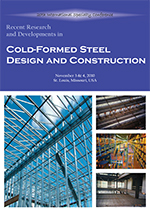Session Dates
03 Nov 2010
Abstract
Self-drilling screws are the primary mean s to fasten cold-formed thin-walled steel members in construction. There are several failure modes for shear connections with self-drilling screws, including screw tilting, hole bearing, edge tearing, tensile fracture in net s ection of connected elements and shear fracture of screws. Meanwhile, the “g roup effect” will exist when a large number of screws are used in a shear connection. A series of tests (75 specimens) on single lap shear connections with self-drilling screws has been carried out and the results report ed in this paper. The end distance, screw spacing, pattern of screws arra ngement and number of screws was varied to determine their influence on shear connection strength. The study focused on the analysis of factors af fecting the shear connection strength, the shear strength estimation of self-drilling screw connections based on different failure modes and the influence of group effect. Finally, a proposed design method and recommendations for Chinese specification GB50018 are presented.
Department(s)
Civil, Architectural and Environmental Engineering
Research Center/Lab(s)
Wei-Wen Yu Center for Cold-Formed Steel Structures
Meeting Name
20th International Specialty Conference on Cold-Formed Steel Structures
Publisher
Missouri University of Science and Technology
Document Version
Final Version
Rights
© 2010 Missouri University of Science and Technology, All rights reserved.
Document Type
Article - Conference proceedings
File Type
text
Language
English
Recommended Citation
Li, Yuangqi and Yao, Xingyou, "Shear Behavior of Screw Connections for Cold-formed Thin-walled Steel Structures" (2010). CCFSS Proceedings of International Specialty Conference on Cold-Formed Steel Structures (1971 - 2018). 6.
https://scholarsmine.mst.edu/isccss/20iccfss/20iccfss-session11/6
Shear Behavior of Screw Connections for Cold-formed Thin-walled Steel Structures
Self-drilling screws are the primary mean s to fasten cold-formed thin-walled steel members in construction. There are several failure modes for shear connections with self-drilling screws, including screw tilting, hole bearing, edge tearing, tensile fracture in net s ection of connected elements and shear fracture of screws. Meanwhile, the “g roup effect” will exist when a large number of screws are used in a shear connection. A series of tests (75 specimens) on single lap shear connections with self-drilling screws has been carried out and the results report ed in this paper. The end distance, screw spacing, pattern of screws arra ngement and number of screws was varied to determine their influence on shear connection strength. The study focused on the analysis of factors af fecting the shear connection strength, the shear strength estimation of self-drilling screw connections based on different failure modes and the influence of group effect. Finally, a proposed design method and recommendations for Chinese specification GB50018 are presented.



